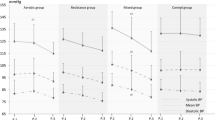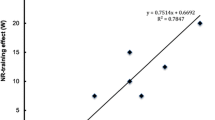Summary
Rats were treated by daily swimming or running exercises for 7 weeks. One group of rats was also trained under the influence of propranolol, while another group received daily propranolol injections only.
The rat groups trained without beta blockade maintained a higher tail skin temperature when exposed to 5‡ C after the 7-week training period. This phenomenon was not observable in the animals having received their training under the influence of beta-blockade. Both rat groups trained without beta-blockade showed increased vasodilatatory response to isoprenaline, as judged from a higher elevation of the tail skin temperature in response to the drug. This response was absent in the animal group having performed its training periods under the influence of propranolol. After the injection of phenylephrine the trained rats had a higher tail skin temperature than did the controls or propranolol-treated rats.
The present results suggest an elevated sensitivity of beta2-adrenoceptors and/or decreased sensitivity of alpha-adrenoceptors in trained rats. It is suggested that for the development of these changes repeated activation of the sympathetic nervous system by exercise periods is needed. That is why they are preventable if the training is performed under the influence of beta-blockade.
Similar content being viewed by others
References
Adams, T., Heberling, E. J.: Human physiological responses to a standardized cold stress as modified by physical fitness. J. Appl. Physiol. 13, 226–230 (1958)
Baldwin, K. M., Cooke, D. A., Cheadle, W. G.: Time course adaptations in cardiac and skeletal muscle to different running programs. J. Appl. Physiol.: Respir. Environ. Exerc. Physiol. 42, 267–272 (1977)
Dowell, R. T., Tipton, C. M.: Influence of training on the heart rate responses of rats to isoproterenol and propranolol. Physiologist 13, 182 (1970)
Fregly, M. J., Resch, G. E., Nelson, E. L., Jr., Field, F. P., Tyler, P. E.: Effect of hypothyroidism on responsiveness to Β-adrenergic stimulation. Can. J. Physiol. Pharmacol. 54, 200–208 (1976)
Fregly, M. J., Thrasher, T. N., Macarthur, S. A., Kelleher, D. L.: Attentuation of a Β-adrenergic response in rats treated chronically with ethyl estradiol. Proc. Soc. Exp. Biol. Med. 157, 17–22 (1978)
Gordon, R., Spector, S., Sjoerdsma, A., Udenfriend, S.: Increased synthesis of norepinephrine and epinephrine in the intact rat during exercise and exposure to cold. J. Pharm. Exp. Ther. 153, 440–447 (1966)
HÄggendal, J., Hartley, L. H., Saltin, B.: Arterial noradrenaline concentration during exercise in relation to the relative work levels. Scand. J. Clin. Lab. Invest. 26, 337–342 (1970)
Harri, M. N. E.: Impaired development of physical fitness resulting from training under the influence of beta-blockade. In: Proceedings: Symposium on physical performance and muscle metabolism. HÄnninen, O., Harri, M. (eds.). The Finnish Society for Research in Sport and Physical Education, Publ. 57. Somerpaino: Somero 1978
Harri, M. N. E., Narvola, I.: Physical training under the influence of beta blockade in rats: effect on adrenergic responses. Eur. J. Appl. Physiol. 41, 199–210 (1979)
Harri, M. N. E., Pelkonen, K. O. H.: Supersensitivity of atrial α-adrenoreceptors following prolonged Β-blockade in rat. In: Recent advantages in the pharmacology of adrenoceptors. Szabadi, E., Bradshaw, C. M., Bevan, P. (eds.), pp. 373–374. Amsterdam: Elsevier, North Holland Biomedical Press 1978
Harri, M. N. E., Valtola, J.: Comparison of the effects of physical exercise, cold acclimation and repeated injections of isoprenaline on rat muscle enzymes. Acta Physiol. Scand. 95, 391–399 (1975)
Heberling, E. J., Adams, T.: Relation of changing level of physical fitness to human cold acclimatization. J. Appl. Physiol. 16, 226–230 (1961)
Honda, N., Judy, M. V., Carlson, L. D.: Effect of adrenaline and noradrenaline on ear vessels in cold- and warm-adapted rabbits. J. Appl. Physiol. 17, 754–758 (1962)
Hsieh, A. C. L., Wang, J. C. C.: Calorigenic responses to cold of rats after prolonged infusion of norepinephrine. Am. J. Physiol. 221, 335–337 (1971)
Janský, L.: Non-shivering thermogenesis and its thermoregulatory significance. Biol. Rev. 48, 85–132 (1973)
Keatinge, W. R.: The effect of repeated daily exposure to cold and of improved physical fitness on the metabolic and vascular response to cold air. J. Physiol. (Lond.) 157, 209–220 (1961)
Koo, A., Liang, I. Y. S.: Microvascular responses to norepinephrine in skeletal muscle of cold-acclimated rats. J. Appl. Physiol.: Respir. Environ. Exerc. Physiol. 44, 190–194 (1978)
LeBlanc, J., Pouliot, M.: Importance of noradrenaline in cold adaptation. Am. J. Physiol. 207, 853–856 (1964)
LeBlanc, J., Villemaire, A.: Thyroxine and noradrenaline on noradrenaline sensitivity, cold resistance, and brown fat. Am. J. Physiol. 218, 1842–1845 (1970)
LedÚc, J.: Catecholamine production and release in exposure and acclimation to cold. Acta Physiol. Scand. [Suppl. 183] 53, 1–123 (1961)
Reite, O. B., Krog, J., Carlson, L. D.: Influence of noradrenaline on vascular resistence in the intact perfused ears of cold-adapted and warm-adapted rabbits. Fed. Proc. 25, 1213–1215 (1966)
Sigvardsson, K., Svanfeldt, E., Kilbom, å.: Role of the adrenergic nervous system in development of training-induced bradycardia. Acta Physiol. Scand. 101, 481–488 (1978)
Siltovuori, A., Tirri, R., Harri, M. N. E.: Alpha-receptor subsensitivity of isolated atria from rats following physical training or repeated ACTH-injections. Acta Physiol. Scand. 99, 457–461 (1977)
StrØmme, S. B., Hammel, H. T.: Effects of physical training on tolerance to cold in rats. J. Appl. Physiol. 23, 815–824 (1967)
Tipton, C. M., Struck, P. J., Baldwin, K. M., Matthes, R. D., Dowell, R. T.: Response of adrenalectomized rats to chronic exercise. Endocrinology 91, 573–579 (1970)
Vallières, J., Bureau, M., LeBlanc, J.: Studies on the sensitization to cardiovascular effects of catecholamines. Can. J. Physiol. Pharmacol. 50, 576–583 (1972)
Wyatt, H. L., Chuck, L., Rabinowitz, B., Tyberg, J. V., Parmley, W. W.: Enhanced cardiac response to catecholamines in physically trained cats. Am. J. Physiol. 234, H608-H613 (1978)
Author information
Authors and Affiliations
Rights and permissions
About this article
Cite this article
Harri, M.N.E. Physical training under the influence of beta-blockade in rats. II: Effects on vascular reactivity. Europ. J. Appl. Physiol. 42, 151–157 (1979). https://doi.org/10.1007/BF00431021
Accepted:
Issue Date:
DOI: https://doi.org/10.1007/BF00431021




